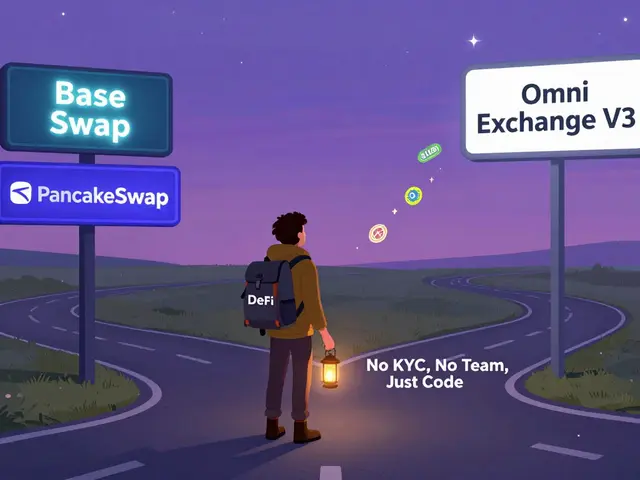Crypto Bear Market Duration Calculator
Calculate how long a crypto bear market might last based on historical patterns and current conditions.
Bear Market Input Parameters
Enter your parameters above to see the expected bear market duration.
Key insights from the article:
- Historical average: 9-14 months (12.7 months on average)
- Shorter bear markets: 4-5 months
- Longer bear markets: up to 20 months
- Stock bear markets average 18 months
- Recent trends show shorter bear markets due to institutional involvement
When Bitcoin dropped from $69,000 in November 2021 to $16,500 in January 2023, millions of crypto holders watched their portfolios shrink by more than 75%. It wasn’t just a dip. It was a crypto bear market - and for many, it felt endless. So how long do these periods actually last? And is the next one going to be the same?
There’s no magic formula, but history gives us a clear pattern. Crypto bear markets don’t last years like they sometimes do in stocks. They’re faster, sharper, and more brutal. On average, they run between 9 and 14 months. The 2017-2018 bear market lasted 13 months. The one right before that, in 2014-2015, stretched 11 months. The most recent one? 14 months. That’s not random. It lines up with Bitcoin’s four-year halving cycle.
Why Do Crypto Bear Markets Happen?
A bear market isn’t just about prices falling. It’s about fear taking over. When Bitcoin or Ethereum drops 20% or more from its peak and keeps sliding, traders start selling. Trading volume drops. New money stops coming in. And suddenly, everyone’s asking: “Is this the end?”
What makes crypto different from stocks is how tightly its cycles are tied to Bitcoin’s halving. Every four years, the reward for mining Bitcoin is cut in half. That usually triggers a bull run - because fewer new coins enter circulation, scarcity kicks in. But after 12 to 18 months of rising prices, the hype fades. Speculators cash out. Liquidity dries up. And then - the bear market begins.
It’s not just Bitcoin, either. Altcoins follow Bitcoin’s lead. When BTC starts falling, most altcoins crash even harder. That’s why you see entire sectors - DeFi, NFTs, memecoins - collapse in unison during these periods.
How Long Do They Typically Last?
Let’s break it down with real numbers:
- 2014-2015 bear market: 11 months (BTC down 83%)
- 2017-2018 bear market: 13 months (BTC down 84%)
- 2021-2023 bear market: 14 months (BTC down 76%)
That’s an average of about 12.7 months. But the range matters too. The shortest bear markets in crypto history lasted only 4 to 5 months. The longest? Just under 20 months - back in 2011-2012, when the market was tiny and far less liquid.
Compare that to the S&P 500. Since 1970, the average stock market bear market lasted 18 months. The 2008 crash? It took 17 months to hit bottom and over two years to recover. Crypto moves faster. It’s younger. More volatile. Less institutional cushion. That means the pain comes quicker - and ends quicker, too.
What’s Changed Since 2022?
The last bear market was brutal. But it also changed everything. Before 2022, crypto was mostly retail traders. Now, institutions control 27% of Bitcoin’s circulating supply - up from just 8% in 2020. BlackRock, Fidelity, and Grayscale are buying Bitcoin in bulk, even when prices are falling.
This changes the game. In past bear markets, when prices dropped, there was no one to support them. Now, ETFs and corporate treasuries keep buying. That’s why the correction after the April 2024 halving was only 35%, not the 75% we saw in 2022. It wasn’t a panic. It was a controlled pullback.
Regulation is another factor. In 2022, uncertainty around SEC lawsuits and exchange shutdowns dragged markets down. Now, with MiCA in Europe and the SEC approving Ethereum ETFs in May 2024, regulatory risk has dropped. That reduces one of the biggest reasons bear markets last longer.
And blockchain usage? It kept growing. While prices were falling, Ethereum processed 37% more daily transactions in 2022 than it did in 2021. Real users, real apps, real value - all still happening. That’s the difference between a speculative bubble and a maturing market.

How Do You Know When It’s Over?
Timing the bottom is impossible. But there are signs you can watch:
- Fear & Greed Index drops below 20 - that’s extreme fear. Historically, that’s when the best buying opportunities appear, usually 4-6 months into the bear market.
- On-chain metrics like NUPL (Net Unrealized Profit/Loss) and MVRV (Market Value to Realized Value) show when most holders are underwater. When these hit multi-month lows, it often means selling pressure is exhausted.
- Trading volume starts creeping back up, especially on major exchanges. No volume = no recovery.
- Social sentiment hits a low. In June 2022, mentions of “crypto winter” hit 18,432 daily mentions. That was the bottom. When everyone gives up, the smart money starts buying.
Don’t wait for the news to say “bull market.” Wait for the data. Most retail traders sell at the bottom because they’re scared. The people who make money wait for confirmation - not hope.
What You Should Do During a Bear Market
If you’re holding crypto, here’s what actually works:
- Dollar-cost average. Buy a fixed amount every week or month, no matter the price. People who did this in 2022 recovered their losses faster than those who tried to time the bottom.
- Keep cash reserves. Have 3-6 months of living expenses in stablecoins or fiat. That way, you don’t have to sell crypto at a loss to pay rent.
- Avoid leverage. Over 87% of liquidations during the 2022 bear market happened to people using 10x or higher leverage. Don’t be one of them.
- Learn. Use the downtime to study. Binance Academy now has 147 bear-market-specific lessons. Most people waste this time scrolling memes. Don’t.
- Ignore the noise. Twitter and Reddit will tell you the market is dead. They said that in 2018 and 2022. It came back stronger both times.
Warren Buffett’s advice still holds: “Be fearful when others are greedy, and greedy when others are fearful.” Crypto bear markets are the best time to accumulate. Not because you’re sure prices will rise - but because you’re prepared for when they do.

Will Bear Markets Get Shorter?
Yes - and that’s the biggest shift.
Before 2022, the average bear market lasted about 9.8 months. Now, 12 major financial institutions predict the next one will last only 8.2 months. Why? Institutional money. ETFs. Better infrastructure. Less regulatory chaos.
By 2027, analysts at Standard Chartered think bear markets could shrink to 4-6 months. That’s not a guess. It’s based on how fast institutional buying is absorbing sell pressure. When BlackRock buys $1.85 billion in Bitcoin in one quarter, it doesn’t just stabilize the market - it shortens the downturn.
But there’s a flip side. If crypto doesn’t build real-world use cases - if it stays just a speculative asset - then bear markets could get longer. More people will bail out. More capital will leave. The market needs utility, not just hype.
Right now, the signs point to shorter, less painful bear markets. But they’re not gone. They’re just evolving.
Final Thought: It’s Not About Timing. It’s About Staying.
The people who made money in crypto didn’t predict the bottom. They didn’t time the halving. They didn’t chase the next memecoin.
They stayed.
They kept buying when everyone else was scared. They held through the nights when their portfolio value dropped 60%. They didn’t panic-sell. They didn’t quit. And when the market turned, they were ready.
How long do crypto bear markets last? Long enough to scare you. Short enough to reward you - if you don’t run.
How long do crypto bear markets usually last?
Historically, crypto bear markets last between 9 and 14 months, with an average of about 12.7 months. The most recent one (2021-2023) lasted 14 months. Shorter bear markets can last 4-5 months, while the longest on record stretched nearly 20 months in the early days of Bitcoin.
Is the next crypto bear market going to be shorter?
Yes, most analysts expect it to be shorter. With institutional investors like BlackRock and Fidelity buying Bitcoin through ETFs, and regulatory clarity improving, bear markets are becoming less severe. Predictions from major banks suggest the next one could last only 6-8 months, down from the historical average of 9.8 months.
What’s the difference between a crypto bear market and a stock market bear market?
Crypto bear markets are faster and sharper. While stock bear markets average 18 months and can last over 2 years, crypto ones typically last under a year and a half. Crypto also sees deeper price drops - Bitcoin fell 76% in the last bear market, while the S&P 500 dropped 25% in 2022. But crypto also recovers faster due to higher volatility and speculative activity.
Can you make money in a crypto bear market?
Absolutely. Many successful investors buy during bear markets. Dollar-cost averaging, accumulating Bitcoin and Ethereum at lower prices, and avoiding leverage are proven strategies. One user on Bitcointalk accumulated 2.5 BTC during the 2022 bear market at an average price of $18,000 - it was worth over $65,000 just 14 months later.
What should I do if my crypto portfolio is down 50%?
Don’t panic. Selling at a loss locks in the loss. Instead, assess your long-term goals. If you still believe in crypto, consider buying more on a schedule - say, $50 a week. Keep cash reserves for living expenses so you don’t have to sell. Most people who recover do so by holding and adding, not by timing the bottom.
Are crypto bear markets getting less risky?
They’re becoming less chaotic, not less risky. Institutional buying reduces extreme volatility. Regulatory clarity helps. But crypto is still young. A single SEC lawsuit or major exchange collapse can still trigger a sharp drop. The risk has shifted from pure speculation to systemic dependencies - like ETFs and banking partnerships.







Caren Potgieter
November 22, 2025 AT 20:13Matthew Prickett
November 23, 2025 AT 20:19Jennifer MacLeod
November 24, 2025 AT 19:24Linda English
November 26, 2025 AT 12:24Jennifer Morton-Riggs
November 27, 2025 AT 00:47Jody Veitch
November 27, 2025 AT 15:59Amanda Cheyne
November 27, 2025 AT 19:47Anne Jackson
November 29, 2025 AT 16:26David Hardy
November 29, 2025 AT 23:16John Borwick
November 30, 2025 AT 04:58asher malik
December 1, 2025 AT 03:13Tyler Boyle
December 2, 2025 AT 17:42Jane A
December 3, 2025 AT 14:52jocelyn cortez
December 4, 2025 AT 15:34Gus Mitchener
December 6, 2025 AT 13:44Matthew Prickett
December 7, 2025 AT 19:23David Hardy
December 9, 2025 AT 07:08John Borwick
December 10, 2025 AT 19:31Linda English
December 12, 2025 AT 05:39